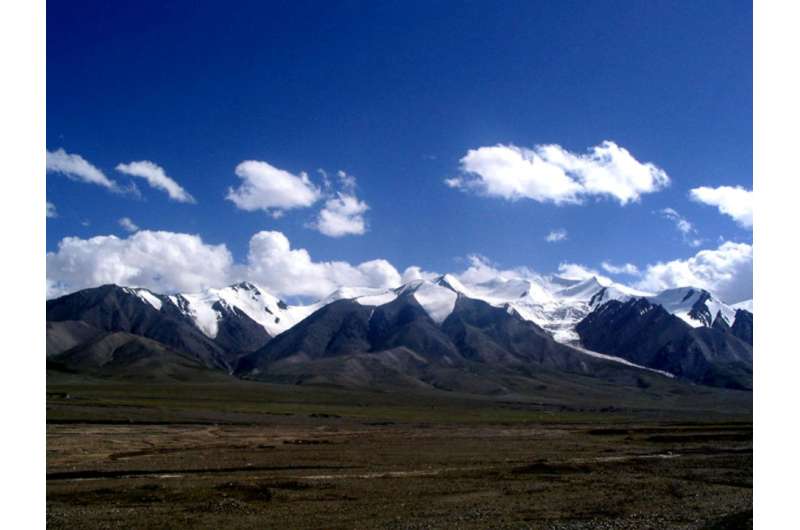View of Western Kunlun Shan from the Tibet-Xinjiang highway. Credit: Wikipedia
(Phys.org)—Hamish Pritchard, a glaciologist with Cambridge University, has conducted a study of Asia's glaciers and how they might be impacted by global warming. In his paper published in the journal Nature, he describes the nature of the glaciers that exist in the high mountains of Asia, which include the Kunlun Shan, Pamir, Karakoram, Hindu Kush and Tian Shan mountains and, of course, the Himalayas. Pritchard looked at how they impact people living in the area and how things might change in light of global warming. Tobias Bolch with the University of Zurich offers a News & Views piece on the work done by Pritchard and adds some perspectives of his own regarding some of the possible changes likely to come about in the places that have become dependent on melting glacial water.
As Pritchard notes, the mountains of Asia have the highest concentration of glaciers in the world and approximately 800 million people living in the area are impacted by the water runoff that occurs as glaciers melt during the warmer months. He also notes that such meltwater provides people that live in the area resistance to droughts. In his analysis, he attempts to outline the possible impact to approximately 136 million people living in countries such as Uzbekistan, Turkmenistan, Kyrgyzstan and Pakistan to changes in the amount of meltwater as the planet continues to warm.
As the planet warms, Pritchard notes, some of the glacial areas will see an increase in runoff as more ice melts each year. This, he also notes, will likely mean more water in the areas downstream for periods of decades to perhaps a century. But as the glaciers shrink, they will eventually produce less runoff, removing the buffer against droughts in the region, which has historically been prone to periodic dry spells. Reduced runoff in other parts of the region, on the other hand, will likely have less impact because they have a monsoon season every summer—though as he further notes, it is still unclear what impact global warming will have on the monsoon season.
But there are other factors to consider, as Bolch notes—many of the countries in the region rely on hydropower from dams built on rivers engorged with glacial melt—also, many reservoirs have been built to hold onto glacial melt to provide water for drinking and energy production during the winter months—an increase in melt in the short-term could overcome such facilities. And as Bolch also points out, Pritchard has been able to show for perhaps the first time the actual impact of glacial meltwater during drought periods in the region over the past several decades. In so doing, he has found that such meltwater has the greatest impact on in the Aral Sea and Indus River catchments and has provided a framework for predicting impacts on the area as the amount of meltwater changes.
More information: Hamish D. Pritchard. Asia's glaciers are a regionally important buffer against drought, Nature (2017). DOI: 10.1038/nature22062
Abstract
The high mountains of Asia—encompassing the Himalayas, the Hindu Kush, Karakoram, Pamir Alai, Kunlun Shan, and Tian Shan mountains—have the highest concentration of glaciers globally, and 800 million people depend in part on meltwater from them. Water stress makes this region vulnerable economically and socially to drought, but glaciers are a uniquely drought-resilient source of water. Here I show that these glaciers provide summer meltwater to rivers and aquifers that is sufficient for the basic needs of 136 million people, or most of the annual municipal and industrial needs of Pakistan, Tajikistan, Turkmenistan, Uzbekistan and Kyrgyzstan. During drought summers, meltwater dominates water inputs to the upper Indus and Aral river basins. Uncertainties in mountain precipitation are poorly known, but, given the magnitude of this water supply, predicted glacier loss would add considerably to drought-related water stress. Such additional water stress increases the risk of social instability, conflict and sudden, uncontrolled population migrations triggered by water scarcity, which is already associated with the large and rapidly growing populations and hydro-economies of these basins.
Journal information: Nature
© 2017 Phys.org
























